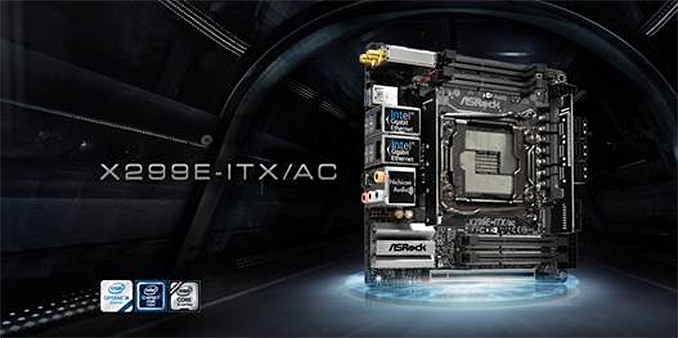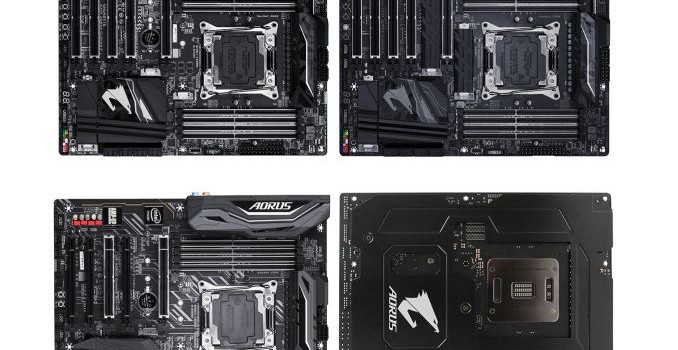Mighty Mini-ITX: ASRock X299E-ITX/ac with 4 Channel DDR4 and 3xM.2 Support
ASRock has announced one of the industry’s first Mini-ITX motherboards for Intel’s latest Core X processors in the LGA2066 packaging. The new X299E-ITX/ac is small, but it takes full advantage of Intel’s new X299 platform, offering support for all CPUs with up to 18 cores, quad-channel DDR4 memory on the higher-end CPUs, three PCIe 3.0 x4 M.2 slots as well as everything that one might expect from a Mini-ITX board, including Wi-Fi.
Besides being a miniature motherboard for Intel’s HEDT processors, the most important aspect of the ASRock X299E-ITX/ac is support for quad-channel memory in this form-factor. The company’s previous-gen Intel X99-based Mini-ITX mainboard was feature-packed, but one of the things it missed was the quad-channel memory sub-system, which had an expected negative effect on performance in applications that required high memory bandwidth. By contrast, the new unit has four SO-DIMM DDR4 memory slots and even supports DDR4 overclocking (assuming that there are SO-DIMMs that can be significantly overclocked). In fact, putting four memory slots onto a small motherboard while also fitting the LGA 2066 socket and required high-capactiy VRMs is a rather remarkable engineering achievement. The flip side however is that the very tightly packed design of the X299E-ITX/ac may impose certain limitations on compatibility with large cooling systems.
Just like every other Mini-ITX motherboard around, the ASRock X299E-ITX/ac has only one PCIe 3.0 x16 slot for graphics cards. In the meantime, the X299E-ITX/ac is the first miniature mainboard to feature three M.2 slots (PCIe 3.0 x4 or SATA) for SSDs. In addition, the board carries six SATA 6 Gbps headers for builds that require multiple storage devices in drive form-factor. It is noteworthy that in order to fit everything it wanted onto a Mini-ITX PCB, ASRock had to place the USB 3.1 controller, SATA ports and one M.2 slot on custom DIMM-like modules – essentially going vertical when they ran out of horizontal space. Such modules add certain dimension-related limitations to the size of CPU radiators (plus, it remains to be seen how higher-end M.2 SSDs perform when located near a CPU cooler), but this is a tradeoff that the manufacturer had to take.
As for connectivity, the X299E-ITX/ac comes with a 2×2 802.11ac Wi-Fi + Bluetooth 4.2 module (based on an Intel controller), two GbE ports (Intel controllers too), two USB 3.1 headers (Type-A and Type-C), six USB 3.0 connectors, 7.1-channel audio sub-system (enabled by the Realtek ALC1220 controller) and so on.
| ASRock’s Mini-ITX Motherboard for Intel Core X-Series | ||
| X299E-ITX/ac | ||
| CPU Support | Intel Core i9 Intel Core i7 Intel Core i5 CPUs in LGA2066 form-factor |
|
| Graphics | PCIe 3.0 x16 | |
| Chipset | Intel X299 | |
| Memory | Four DDR4 SO-DIMM slots | |
| Ethernet | 2 × Intel GbE controllers | |
| Storage | 6 × SATA 6 Gbps 3 × M.2 (PCIe 3.0 x4 or SATA) |
|
| Audio | Realtek ALC1220 7.1 channel audio |
|
| USB | 6 × USB 3.0 Type-A 1 × USB 3.1 Type-A 1 × USB 3.1 Type-C |
|
| Other I/O | Dual band 802.11ac Wi-Fi + Bluetooth 4.2 | |
| Form-Factor | Mini-ITX | |
| MSRP | $280 ~ $300 | |
The ASRock X299E-ITC/ac will be available in the coming months for about $280 – $300, depending on the region and other factors. Such a price point is considerably higher than MSRPs of most Mini-ITX motherboards, but given the fact that this is a very high-end platform (with equally high component requirements) aimed at enthusiasts, it is not unusual. In fact, from many standpoint it may be considered as an entry-level X299 board simply because it does not provide opulence of its bigger brethren.
Related Reading:

































